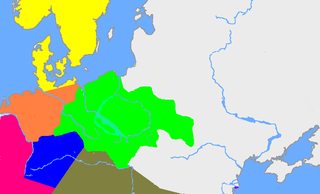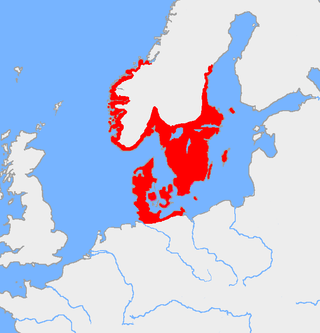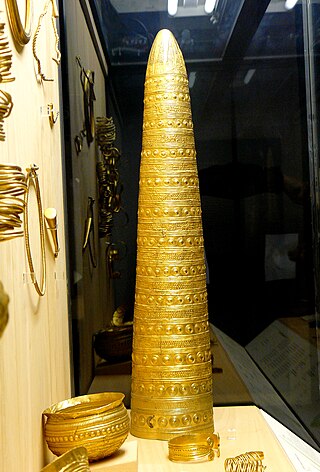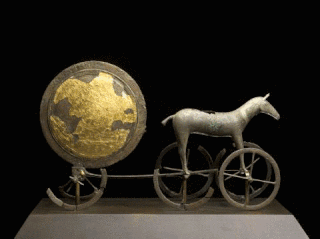
A solar deity or sun deity is a deity who represents the Sun or an aspect thereof. Such deities are usually associated with power and strength. Solar deities and Sun worship can be found throughout most of recorded history in various forms. The Sun is sometimes referred to by its Latin name Sol or by its Greek name Helios. The English word sun derives from Proto-Germanic *sunnǭ.

The Urnfield culture was a late Bronze Age culture of Central Europe, often divided into several local cultures within a broader Urnfield tradition. The name comes from the custom of cremating the dead and placing their ashes in urns, which were then buried in fields. The first usage of the name occurred in publications over grave sites in southern Germany in the late 19th century. Over much of Europe, the Urnfield culture followed the Tumulus culture and was succeeded by the Hallstatt culture. Some linguists and archaeologists have associated this culture with a pre-Celtic language or Proto-Celtic language family. By the end of the 2nd millennium BC, the Urnfield Tradition had spread through Italy, northwestern Europe, and as far west as the Pyrenees. It is at this time that fortified hilltop settlements and sheet‐bronze metalworking also spread widely across Europe, leading some authorities to equate these changes with the expansion of the Celts. These links are no longer accepted. The Italic peoples, including the Latins, from which the Romans emerged, come from the Urnfield culture of central Europe.

The Nebra sky disc is a bronze disc of around 30 cm (12 in) diameter and a weight of 2.2 kg (4.9 lb), having a blue-green patina and inlaid with gold symbols. These symbols are interpreted generally as the Sun or full moon, a lunar crescent, and stars. Two golden arcs along the sides are thought to mark the angle between the solstices. Another arc at the bottom with internal parallel lines is usually interpreted as a solar boat with numerous oars, though some authors have also suggested that it may represent a rainbow, the Aurora Borealis, a comet, or a sickle.

The Lusatian culture existed in the later Bronze Age and early Iron Age in most of what is now Poland and parts of the Czech Republic, Slovakia, eastern Germany and western Ukraine. It covers the Periods Montelius III to V of the Northern European chronological scheme. It has been associated or closely linked with the Nordic Bronze Age. Hallstatt influences can also be seen particularly in ornaments and weapons.

The Únětice culture, Aunjetitz culture or Unetician culture is an archaeological culture at the start of the Central European Bronze Age, dated roughly to about 2300–1600 BC. The eponymous site for this culture, the village of Únětice, is located in the central Czech Republic, northwest of Prague. There are about 1,400 documented Únětice culture sites in the Czech Republic and Slovakia, 550 sites in Poland, and, in Germany, about 500 sites and loose finds locations. The Únětice culture is also known from north-eastern Austria, and from western Ukraine.

A sun cross, solar cross, or wheel cross is a solar symbol consisting of an equilateral cross inside a circle.

The Nordic Bronze Age is a period of Scandinavian prehistory from c. 2000/1750–500 BC.

Caergwrle is a village in the county of Flintshire, in north east Wales. Approximately 5–6 miles (8.0–9.7 km) from Wrexham and situated on the A541 road, it is contiguous with the villages of Abermorddu and Hope, though in parts Caergwrle and Hope are separated by a river border. The village lies on the River Alyn and sits at the base of Hope Mountain. At the 2001 Census, the population was 1,650. The population was subsequently absorbed in the community of Hope and only the electoral ward remained. The population of this ward as taken at the 2011 census was 1,619. The ward includes the area of Abermorddu. Further south is the village of Cefn-y-Bedd.

Sól or Sunna is the Sun personified in Germanic mythology. One of the two Old High German Merseburg Incantations, written in the 9th or 10th century CE, attests that Sunna is the sister of Sinthgunt. In Norse mythology, Sól is attested in the Poetic Edda, compiled in the 13th century from earlier traditional sources, and the Prose Edda, written in the 13th century by Snorri Sturluson.

The King's Grave is an archaeological site. It is situated near Kivik in the southeastern portion of Scania, Sweden. The site is what remains of an unusually grand Nordic Bronze Age double burial dating from circa the 15th century BC.

Nebra or Raneb is the Horus name of the second early Egyptian king of the 2nd Dynasty. The exact length of his reign is unknown since the Turin canon is damaged and the year accounts are lost. Manetho suggests that Nebra's reign lasted 39 years, but Egyptologists question Manetho's view as a misinterpretation or exaggeration of information that was available to him. They credit Nebra with either a 10- or 14-year rule.

Golden hats are a very specific and rare type of archaeological artifact from Bronze Age Europe. So far, four such objects are known. The objects are made of thin sheet gold and were attached externally to long conical and brimmed headdresses which were probably made of some organic material and served to stabilise the external gold leaf. The following conical golden hats are known as of 2012:

The Trundholm sun chariot is a Nordic Bronze Age artifact discovered in Denmark. It is a representation of the sun chariot, a bronze statue of a horse and a large bronze disk, which are placed on a device with spoked wheels.
The European Bronze Age is characterized by bronze artifacts and the use of bronze implements. The regional Bronze Age succeeds the Neolithic and Copper Age and is followed by the Iron Age. It starts with the Aegean Bronze Age in 3200 BC and spans the entire 2nd millennium BC, lasting until c. 800 BC in central Europe.

Bush Barrow is a site of the early British Bronze Age Wessex culture, at the western end of the Normanton Down Barrows cemetery in Wiltshire, England. It is among the most important sites of the Stonehenge complex, having produced some of the most spectacular grave goods in Britain. It was excavated in 1808 by William Cunnington for Sir Richard Colt Hoare. The finds, including worked gold objects, are displayed at Wiltshire Museum in Devizes.

The Golden Cone of Ezelsdorf-Buch is a Late Bronze Age artefact discovered in 1953 between the villages of Ezelsdorf and Buch in Southern Germany. A tall (88 cm), cone-shaped object made of thin sheet gold, it is seen as belonging to a group of artifacts referred to as Bronze Age Golden hats. It was presumably worn by special functionaries on ceremonial occasions.

The Leubingen tumulus is an early bronze age "princely" grave of the Leubingen culture,, dating to about 1940 BC. It is located near the hills of Kyffhäuser in Leubingen, an Ortsteil of Sömmerda in the eastern German state of Thuringia.

The Caergwrle Bowl is a unique object dating to the Middle Bronze Age, c. 1300 BC, originally manufactured from shale, tin and gold, and found in Caergwrle, Flintshire, north east Wales. It is thought to represent a boat, with its applied gold decoration signifying oars and waves, and either sun discs or circular shields. At both ends of the boat is a pair of oculi or 'eyes'.

The Carnon River is a heavily polluted river in Cornwall, England, United Kingdom. It starts in Chacewater. Both Trewedna Water and River Kennall flow into the Carnon before it merges with Tallack's Creek to become Restronguet Creek, which eventually flows into the English Channel at the mouth of Carrick Roads.